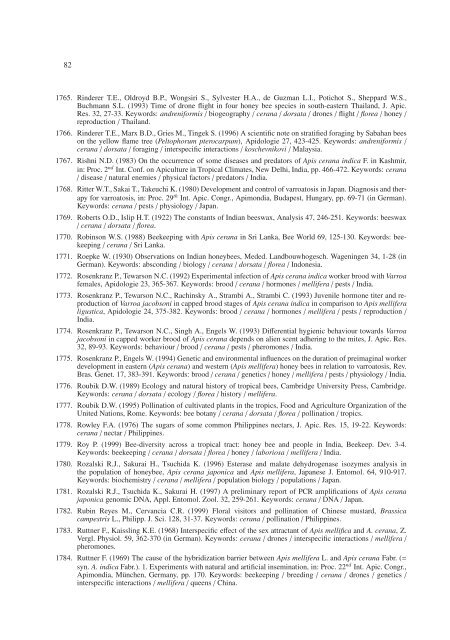Bibliography of Apis cerana Fabricius - Apidologie
Bibliography of Apis cerana Fabricius - Apidologie
Bibliography of Apis cerana Fabricius - Apidologie
Create successful ePaper yourself
Turn your PDF publications into a flip-book with our unique Google optimized e-Paper software.
82<br />
1765. Rinderer T.E., Oldroyd B.P., Wongsiri S., Sylvester H.A., de Guzman L.I., Potichot S., Sheppard W.S.,<br />
Buchmann S.L. (1993) Time <strong>of</strong> drone flight in four honey bee species in south-eastern Thailand, J. Apic.<br />
Res. 32, 27-33. Keywords: andreniformis / biogeography / <strong>cerana</strong> / dorsata / drones / flight / florea / honey /<br />
reproduction / Thailand.<br />
1766. Rinderer T.E., Marx B.D., Gries M., Tingek S. (1996) A scientific note on stratified foraging by Sabahan bees<br />
on the yellow flame tree (Peltophorum pterocarpum), <strong>Apidologie</strong> 27, 423-425. Keywords: andreniformis /<br />
<strong>cerana</strong> / dorsata / foraging / interspecific interactions / koschevnikovi / Malaysia.<br />
1767. Rishni N.D. (1983) On the occurrence <strong>of</strong> some diseases and predators <strong>of</strong> <strong>Apis</strong> <strong>cerana</strong> indica F. in Kashmir,<br />
in: Proc. 2nd Int. Conf. on Apiculture in Tropical Climates, New Delhi, India, pp. 466-472. Keywords: <strong>cerana</strong><br />
/ disease / natural enemies / physical factors / predators / India.<br />
1768. Ritter W.T., Sakai T., Takeuchi K. (1980) Development and control <strong>of</strong> varroatosis in Japan. Diagnosis and therapy<br />
for varroatosis, in: Proc. 29th Int. Apic. Congr., Apimondia, Budapest, Hungary, pp. 69-71 (in German).<br />
Keywords: <strong>cerana</strong> / pests / physiology / Japan.<br />
1769. Roberts O.D., Islip H.T. (1922) The constants <strong>of</strong> Indian beeswax, Analysis 47, 246-251. Keywords: beeswax<br />
/ <strong>cerana</strong> / dorsata / florea.<br />
1770. Robinson W.S. (1988) Beekeeping with <strong>Apis</strong> <strong>cerana</strong> in Sri Lanka, Bee World 69, 125-130. Keywords: beekeeping<br />
/ <strong>cerana</strong> / Sri Lanka.<br />
1771. Roepke W. (1930) Observations on Indian honeybees, Meded. Landbouwhogesch. Wageningen 34, 1-28 (in<br />
German). Keywords: absconding / biology / <strong>cerana</strong> / dorsata / florea / Indonesia.<br />
1772. Rosenkranz P., Tewarson N.C. (1992) Experimental infection <strong>of</strong> <strong>Apis</strong> <strong>cerana</strong> indica worker brood with Varroa<br />
females, <strong>Apidologie</strong> 23, 365-367. Keywords: brood / <strong>cerana</strong> / hormones / mellifera / pests / India.<br />
1773. Rosenkranz P., Tewarson N.C., Rachinsky A., Strambi A., Strambi C. (1993) Juvenile hormone titer and reproduction<br />
<strong>of</strong> Varroa jacobsoni in capped brood stages <strong>of</strong> <strong>Apis</strong> <strong>cerana</strong> indica in comparison to <strong>Apis</strong> mellifera<br />
ligustica, <strong>Apidologie</strong> 24, 375-382. Keywords: brood / <strong>cerana</strong> / hormones / mellifera / pests / reproduction /<br />
India.<br />
1774. Rosenkranz P., Tewarson N.C., Singh A., Engels W. (1993) Differential hygienic behaviour towards Varroa<br />
jacobsoni in capped worker brood <strong>of</strong> <strong>Apis</strong> <strong>cerana</strong> depends on alien scent adhering to the mites, J. Apic. Res.<br />
32, 89-93. Keywords: behaviour / brood / <strong>cerana</strong> / pests / pheromones / India.<br />
1775. Rosenkranz P., Engels W. (1994) Genetic and environmental influences on the duration <strong>of</strong> preimaginal worker<br />
development in eastern (<strong>Apis</strong> <strong>cerana</strong>) andwestern(<strong>Apis</strong> mellifera) honey bees in relation to varroatosis, Rev.<br />
Bras. Genet. 17, 383-391. Keywords: brood / <strong>cerana</strong> / genetics / honey / mellifera / pests / physiology / India.<br />
1776. Roubik D.W. (1989) Ecology and natural history <strong>of</strong> tropical bees, Cambridge University Press, Cambridge.<br />
Keywords: <strong>cerana</strong> / dorsata / ecology / florea / history / mellifera.<br />
1777. Roubik D.W. (1995) Pollination <strong>of</strong> cultivated plants in the tropics, Food and Agriculture Organization <strong>of</strong> the<br />
United Nations, Rome. Keywords: bee botany / <strong>cerana</strong> / dorsata / florea / pollination / tropics.<br />
1778. Rowley F.A. (1976) The sugars <strong>of</strong> some common Philippines nectars, J. Apic. Res. 15, 19-22. Keywords:<br />
<strong>cerana</strong> / nectar / Philippines.<br />
1779. Roy P. (1999) Bee-diversity across a tropical tract: honey bee and people in India, Beekeep. Dev. 3-4.<br />
Keywords: beekeeping / <strong>cerana</strong> / dorsata / florea / honey / laboriosa / mellifera / India.<br />
1780. Rozalski R.J., Sakurai H., Tsuchida K. (1996) Esterase and malate dehydrogenase isozymes analysis in<br />
the population <strong>of</strong> honeybee, <strong>Apis</strong> <strong>cerana</strong> japonica and <strong>Apis</strong> mellifera, Japanese J. Entomol. 64, 910-917.<br />
Keywords: biochemistry / <strong>cerana</strong> / mellifera / population biology / populations / Japan.<br />
1781. Rozalski R.J., Tsuchida K., Sakurai H. (1997) A preliminary report <strong>of</strong> PCR amplifications <strong>of</strong> <strong>Apis</strong> <strong>cerana</strong><br />
japonica genomic DNA, Appl. Entomol. Zool. 32, 259-261. Keywords: <strong>cerana</strong> / DNA / Japan.<br />
1782. Rubin Reyes M., Cervancia C.R. (1999) Floral visitors and pollination <strong>of</strong> Chinese mustard, Brassica<br />
campestris L., Philipp. J. Sci. 128, 31-37. Keywords: <strong>cerana</strong> / pollination / Philippines.<br />
1783. Ruttner F., Kaissling K.E. (1968) Interspecific effect <strong>of</strong> the sex attractant <strong>of</strong> <strong>Apis</strong> mellifica and A. <strong>cerana</strong>, Z.<br />
Vergl. Physiol. 59, 362-370 (in German). Keywords: <strong>cerana</strong> / drones / interspecific interactions / mellifera /<br />
pheromones.<br />
1784. Ruttner F. (1969) The cause <strong>of</strong> the hybridization barrier between <strong>Apis</strong> mellifera L. and <strong>Apis</strong> <strong>cerana</strong> Fabr. (=<br />
syn. A. indica Fabr.). 1. Experiments with natural and artificial insemination, in: Proc. 22nd Int. Apic. Congr.,<br />
Apimondia, München, Germany, pp. 170. Keywords: beekeeping / breeding / <strong>cerana</strong> / drones / genetics /<br />
interspecific interactions / mellifera / queens / China.




